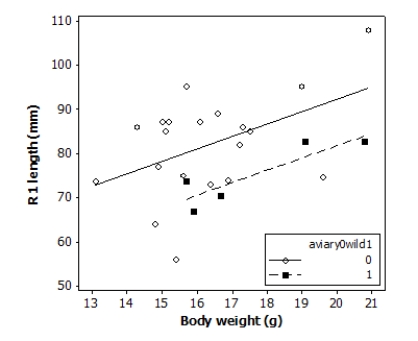Multiple Choice
Tail-feather length is a sexually dimorphic trait in long-tailed finches; that is, the trait differs substantially for males and for females of the same species. A bird's size and environment might also influence tail-feather length. Researchers studied the relationship between tail-feather length (measuring the R1 central tail feather) and weight in a sample of 20 male long-tailed finches raised in an aviary and 5 male long-tailed finches caught in the wild. The data are displayed in the scatterplot below.
 The following model is proposed for predicting the length of the R1 feather from the bird's weight and origin:
The following model is proposed for predicting the length of the R1 feather from the bird's weight and origin:
R1Lengthi = β0 + β1 (BodyWeighti) + β2 (Aviary0Wild1i) + εi
Where the deviations εi were assumed to be independent and Normally distributed with mean 0 and standard deviation σ . This model was fit to the sample of 25 male finches. The following results summarize the least-squares regression fit of this model:
Using a significance level of 0.05, what should you conclude about long-tailed finches, based on your calculations for a confidence interval for β1 and for a test of hypothesis on β2?
A) A bird's body weight and origin both significantly explain tail-feather length.
B) A bird's body weight significantly helps explain tail-feather length, even after accounting for the bird's origin, and a bird's origin significantly helps explain tail-feather length, even after accounting for the bird's body weight.
C) A bird's body weight significantly helps explain tail-feather length, even after accounting for the bird's origin, but a bird's origin does not significantly help explain tail-feather length after accounting for the bird's body weight.
D) A bird's origin significantly helps explain tail-feather length even after accounting for the bird's body weight, but a bird's body weight does not significantly help explain tail-feather length after accounting for the bird's origin.
Correct Answer:

Verified
Correct Answer:
Verified
Q18: A study examined the effect of
Q19: Tail-feather length is a sexually dimorphic
Q20: A case study enrolled case individuals
Q21: Tail-feather length is a sexually dimorphic
Q22: A study examined the effect of
Q23: Researchers investigated the effects of acute
Q24: Researchers investigated the effects of acute
Q25: Tail-feather length is a sexually dimorphic
Q27: Tail-feather length is a sexually dimorphic
Q28: A study looked for a protein